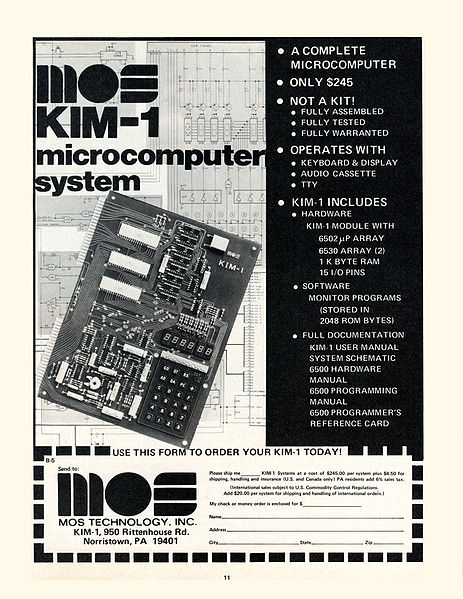Part of the charm of the home computer age - which lasted from roughly 1975 to roughly 1994 - is the sheer mind boggling variety of different computer models that were available. And I don't mean different models as in the 1200 types of Dell or 9 different types of Apple you can buy today, I mean different as in different.
Every single brand of home computer was completely and radically incompatible with every other brand*. Most of the time, different home computers belonging to the same brand - or even same product family - were just as incompatible. Every architecture you can possibly imagine was tried out, including some pretty silly ones.
Never mind trying to exchange data between competing brands, sometimes you couldn't even put one machine's floppy disks in the other machine's floppy drive... The disk just wouldn't physically fit!
All this wonderful variety deserves some long overdue recognition, so the 6502 Spotlight shows of some of the more interesting models of 6502 based home computers. Starting with, of course, the very first 6502 home computer ever made: the MOS KIM-1

Above: An advert from 1976 for the MOS Technology, Inc KIM-1 computer.
Released in 1976 by MOS Technology, the KIM-1 was designed by Chuck Peddle for a very important purpose: the newly released MOS 6502 didn't actually have any computer or motherboard available that was capable of using it. The KIM-1 was designed to fill this rather worrisome gap, giving engineers, programmers and (as a convenient and rather unintentional by-product) hobbyists the ability to work with this remarkable little processor.
The KIM-1 featured slightly over 1Kb of RAM (1152 bytes to be exact), a 6 digit LED display, a 24-key keypad and various I/O ports. Entering programs was done with this 24-key keypad, looking at the responses from the LED display to see what your creations did. You could also save data to audio tape and expand the memory to at the very least 4Kb.
Why it is interesting:
Notable software available includes:
Some KIM-1 trivia:
Interesting sites about the KIM-1 include:
Personal notes on the KIM-1:
*) Unless you got yourself an MSX, in which case your machine was just incompatible with every non-MSX about instead. Which handily outnumbered the MSX machines, so you didn't gain much.
Every single brand of home computer was completely and radically incompatible with every other brand*. Most of the time, different home computers belonging to the same brand - or even same product family - were just as incompatible. Every architecture you can possibly imagine was tried out, including some pretty silly ones.
Never mind trying to exchange data between competing brands, sometimes you couldn't even put one machine's floppy disks in the other machine's floppy drive... The disk just wouldn't physically fit!
All this wonderful variety deserves some long overdue recognition, so the 6502 Spotlight shows of some of the more interesting models of 6502 based home computers. Starting with, of course, the very first 6502 home computer ever made: the MOS KIM-1

Above: An advert from 1976 for the MOS Technology, Inc KIM-1 computer.
Released in 1976 by MOS Technology, the KIM-1 was designed by Chuck Peddle for a very important purpose: the newly released MOS 6502 didn't actually have any computer or motherboard available that was capable of using it. The KIM-1 was designed to fill this rather worrisome gap, giving engineers, programmers and (as a convenient and rather unintentional by-product) hobbyists the ability to work with this remarkable little processor.
The KIM-1 featured slightly over 1Kb of RAM (1152 bytes to be exact), a 6 digit LED display, a 24-key keypad and various I/O ports. Entering programs was done with this 24-key keypad, looking at the responses from the LED display to see what your creations did. You could also save data to audio tape and expand the memory to at the very least 4Kb.
Why it is interesting:
- It's the very first 6502 based computer!
- It comes complete without any screen, the LEDs are all you get.
- It's similar in idea to modern development boards, like the ones you can find for any random ARM core.
Notable software available includes:
- MicroChess, a chess program.
- Tinybasic, a basic interpreter which needed at least 4Kb of ram and 15 minutes of loading from tape to start.
Some KIM-1 trivia:
- MOS Technology was bought by Commodore shortly after the release of the KIM-1 and they eventually created a successor based on the same hardware with a basic ROM and a video driver: the Commodore PET.
- There is an - obviously not full speed - KIM-1 emulator for the Commodore 64.
- You can actually buy a modern version of the KIM-1, with optional 32Kb RAM expansion.
- There is a book on how to use your KIM-1 to control a home made robot.
Interesting sites about the KIM-1 include:
- The Floodgap Retrobits Commodore KIM-1 page
- The @Com KIM-1 Computer page
Personal notes on the KIM-1:
- I don't own, nor have ever owned a KIM-1, but I find it a fascinating piece of technology.
- If I had owned one, I'd definitely have tried making that robot!
*) Unless you got yourself an MSX, in which case your machine was just incompatible with every non-MSX about instead. Which handily outnumbered the MSX machines, so you didn't gain much.